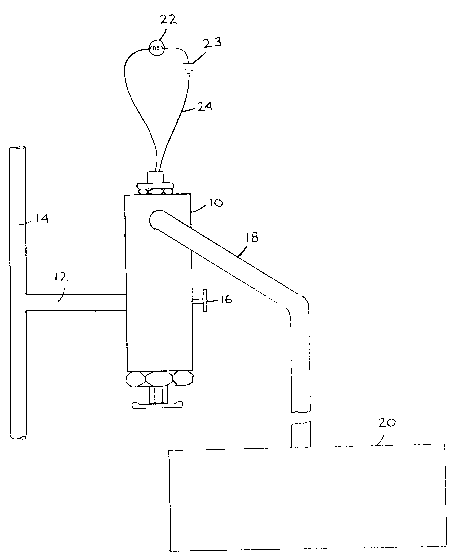Une partie des informations de ce site Web a été fournie par des sources externes. Le gouvernement du Canada n'assume aucune responsabilité concernant la précision, l'actualité ou la fiabilité des informations fournies par les sources externes. Les utilisateurs qui désirent employer cette information devraient consulter directement la source des informations. Le contenu fourni par les sources externes n'est pas assujetti aux exigences sur les langues officielles, la protection des renseignements personnels et l'accessibilité.
L'apparition de différences dans le texte et l'image des Revendications et de l'Abrégé dépend du moment auquel le document est publié. Les textes des Revendications et de l'Abrégé sont affichés :
| (12) Brevet: | (11) CA 2002808 |
|---|---|
| (54) Titre français: | APPAREIL D'ECHANTILLONNAGE D'UN FLUIDE EN CIRCULATION |
| (54) Titre anglais: | DEVICE FOR SAMPLING A CIRCULATING FLUID |
| Statut: | Périmé et au-delà du délai pour l’annulation |
| (51) Classification internationale des brevets (CIB): |
|
|---|---|
| (72) Inventeurs : |
|
| (73) Titulaires : |
|
| (71) Demandeurs : |
|
| (74) Agent: | DOUGLAS B. THOMPSONTHOMPSON, DOUGLAS B. |
| (74) Co-agent: | |
| (45) Délivré: | 1996-02-20 |
| (22) Date de dépôt: | 1989-11-10 |
| (41) Mise à la disponibilité du public: | 1991-05-10 |
| Requête d'examen: | 1992-10-22 |
| Licence disponible: | S.O. |
| Cédé au domaine public: | S.O. |
| (25) Langue des documents déposés: | Anglais |
| Traité de coopération en matière de brevets (PCT): | Non |
|---|
| (30) Données de priorité de la demande: | S.O. |
|---|
A device is provided for sampling the contents of a
pressurized circulating fluid system of a machine. The device is
incorporated in a parallel fluid circuit and comprises a housing
with an inlet to, and outlet from, a cavity. A filter is received
within the cavity. When the filter becomes clogged, a
differential pressure sensor provides an indication for an
operator to close the inlet to the filter cavity, drain the cavity
by means of a valve, and then remove the filter by removing a
plug. The drained cavity fluid and filter may then be shipped to
a lab for testing and the filter replaced and the inlet to the
cavity reopened.
Note : Les revendications sont présentées dans la langue officielle dans laquelle elles ont été soumises.
Note : Les descriptions sont présentées dans la langue officielle dans laquelle elles ont été soumises.

2024-08-01 : Dans le cadre de la transition vers les Brevets de nouvelle génération (BNG), la base de données sur les brevets canadiens (BDBC) contient désormais un Historique d'événement plus détaillé, qui reproduit le Journal des événements de notre nouvelle solution interne.
Veuillez noter que les événements débutant par « Inactive : » se réfèrent à des événements qui ne sont plus utilisés dans notre nouvelle solution interne.
Pour une meilleure compréhension de l'état de la demande ou brevet qui figure sur cette page, la rubrique Mise en garde , et les descriptions de Brevet , Historique d'événement , Taxes périodiques et Historique des paiements devraient être consultées.
| Description | Date |
|---|---|
| Inactive : Renversement de l'état périmé | 2012-12-02 |
| Le délai pour l'annulation est expiré | 2009-11-10 |
| Inactive : Demande ad hoc documentée | 2009-01-29 |
| Lettre envoyée | 2008-11-10 |
| Inactive : CIB de MCD | 2006-03-11 |
| Inactive : CIB de MCD | 2006-03-11 |
| Inactive : CIB de MCD | 2006-03-11 |
| Accordé par délivrance | 1996-02-20 |
| Exigences pour une requête d'examen - jugée conforme | 1992-10-22 |
| Toutes les exigences pour l'examen - jugée conforme | 1992-10-22 |
| Demande publiée (accessible au public) | 1991-05-10 |
Il n'y a pas d'historique d'abandonnement
Le dernier paiement a été reçu le
Avis : Si le paiement en totalité n'a pas été reçu au plus tard à la date indiquée, une taxe supplémentaire peut être imposée, soit une des taxes suivantes :
Veuillez vous référer à la page web des taxes sur les brevets de l'OPIC pour voir tous les montants actuels des taxes.
| Type de taxes | Anniversaire | Échéance | Date payée |
|---|---|---|---|
| TM (brevet, 8e anniv.) - petite | 1997-11-10 | 1997-11-06 | |
| TM (brevet, 9e anniv.) - petite | 1998-11-10 | 1998-10-06 | |
| TM (brevet, 10e anniv.) - petite | 1999-11-10 | 1999-09-29 | |
| TM (brevet, 11e anniv.) - petite | 2000-11-10 | 2000-10-24 | |
| TM (brevet, 12e anniv.) - petite | 2001-11-12 | 2001-10-15 | |
| TM (brevet, 13e anniv.) - petite | 2002-11-11 | 2002-10-31 | |
| TM (brevet, 14e anniv.) - petite | 2003-11-10 | 2003-10-21 | |
| TM (brevet, 15e anniv.) - petite | 2004-11-10 | 2004-09-01 | |
| TM (brevet, 16e anniv.) - petite | 2005-11-10 | 2005-10-04 | |
| 2006-10-03 | |||
| TM (brevet, 17e anniv.) - petite | 2006-11-10 | 2006-10-03 | |
| TM (brevet, 18e anniv.) - générale | 2007-11-12 | 2007-10-31 | |
| TM (demande, 2e anniv.) - petite | 02 | 1991-11-11 |
Les titulaires actuels et antérieures au dossier sont affichés en ordre alphabétique.
| Titulaires actuels au dossier |
|---|
| FLUID LIFE CORPORATION (THE) |
| Titulaires antérieures au dossier |
|---|
| JAMES E., JR. MULLIS |
| JAMES E., SR. MULLIS |